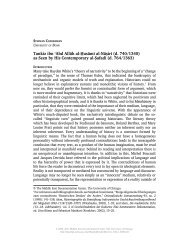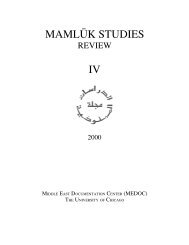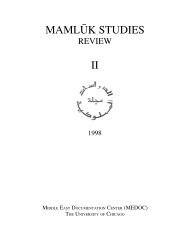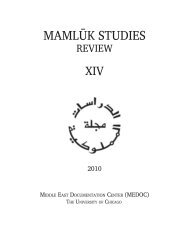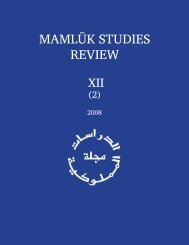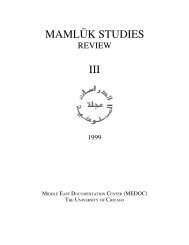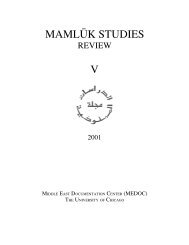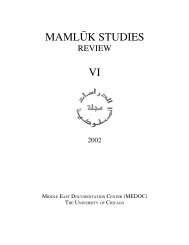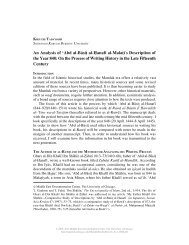Vol. VIII, no. 2 (2004) - Mamluk Studies Review - University of Chicago
Vol. VIII, no. 2 (2004) - Mamluk Studies Review - University of Chicago
Vol. VIII, no. 2 (2004) - Mamluk Studies Review - University of Chicago
You also want an ePaper? Increase the reach of your titles
YUMPU automatically turns print PDFs into web optimized ePapers that Google loves.
MAMLU±K STUDIES REVIEW VOL. 8, NO. 2, <strong>2004</strong> 17<br />
the Arab tribes in his geographical work Masa≠lik al-Abs˝a≠r, makes a consistent<br />
distinction between the original ‘arab, or Arabs, and the contemporary Arab<br />
tribes, "the ‘urba≠n found in our time." 66 In al-‘Umar|'s view, the ‘urba≠n are those<br />
who claim Arab descent and who subscribe to the values <strong>of</strong> the <strong>no</strong>madic life-style,<br />
even if they <strong>no</strong> longer practice it. 67 While al-‘Umar| eulogizes the <strong>no</strong>madic way <strong>of</strong><br />
life, 68 he <strong>no</strong>netheless ack<strong>no</strong>wledges that many Syrian tribes have settled down.<br />
These tribes, he says, were originally Arab but are <strong>no</strong> longer so, as they became<br />
h˝ad˝ar|s, settled people who cultivate agriculture. 69 The list that follows is organized<br />
by localities, each locality with its tribal inhabitants. Among the places mentioned<br />
are the cities <strong>of</strong> Gaza, Hebron, Jerusalem, Nablus, ‘Ajla≠n, Adhru‘a≠t, H˛ims˝, H˛ama≠h<br />
and Shayzar. By the end <strong>of</strong> the long list, which al-‘Umar| admits to be incomplete,<br />
it is clear that much <strong>of</strong> the Syrian peasantry claimed Arab origins. 70<br />
In Egypt, according to al-‘Umar|, almost all the ‘urba≠n were settled cultivators.<br />
The Banu≠ al-Zubayr, who dwelled in the province <strong>of</strong> al-Bahnasa≠, are described as<br />
submissive artisans and peasants. 71 The five sections <strong>of</strong> the Banu≠ Sa‘d <strong>of</strong> the<br />
Judha≠m mostly practiced agriculture and husbandry. The Banu≠ ‘Abd al-Z˛a≠hir<br />
were a lineage <strong>of</strong> scribes. 72 In his administrative work Al-Ta‘r|f, al-‘Umar| claims<br />
that only the Arabs <strong>of</strong> the western province <strong>of</strong> al-Buh˝ayrah have the true traits and<br />
mores <strong>of</strong> Arabs, because these tribes were truly <strong>no</strong>madic and traveled as far as<br />
al-Qayrawa≠n and Gabes. He also singles out the Arabs <strong>of</strong> the province <strong>of</strong> al-<br />
Sharq|yah as having special status in the eyes <strong>of</strong> the sultan. 73 In these two provinces<br />
<strong>of</strong> Lower Egypt, in which the land is more suitable for grazing than for intensive<br />
agriculture, the Arab tribes undertook the defense <strong>of</strong> their own districts, unlike the<br />
other provinces, where the ‘urba≠n were only responsible for maintaining the<br />
roads. 74 But the rest <strong>of</strong> the Arab tribes are <strong>no</strong>t held in great respect, because:<br />
66<br />
This distinction was apparently drawn from al-H˛amda≠n|'s thirteenth-century treatise, <strong>no</strong>w lost<br />
(Ibn Fad˝l Alla≠h al-‘Umar|, Masa≠lik al-Abs˝a≠r, 71, 157).<br />
67<br />
Ibid., 69.<br />
68 Ibid., 35, 124–36.<br />
69 "Wa-bi-al-Sha≠m min s˝al|bat al-‘arab qad kharaju≠ bi-ha≠ ‘an h˝ukm al-‘arab wa-s˝a≠ru≠ bi-ha≠ ahl<br />
h˝a≠d˝irah sa≠kinah wa-‘umma≠r diya≠r kat¸inah" (ibid., 154).<br />
70 Ibid., 154–55. On the diversity <strong>of</strong> bedouin eco<strong>no</strong>my in Syria see also Ibn H˛awqal, Kita≠b S˛u≠rat<br />
al-Ard˝, ed. J. H. Kramers (Paris, 1964), 222.<br />
71 Ibn Fad˝l Alla≠h al-‘Umar|, Masa≠lik al-Abs˝a≠r, 160–62. Also in al-Maqr|z|, Baya≠n, 41; al-<br />
Qalqashand|, Qala≠’id, 148.<br />
72 Ibn Fad˝l Alla≠h al-‘Umar|, Masa≠lik al-Abs˝a≠r, 174; al-Maqr|z|, Baya≠n, 23. The chronicler and<br />
bureaucrat Ibn ‘Abd al-Z˛a≠hir belonged to this lineage.<br />
73 Ibn Fad˝l Alla≠h al-‘Umar|, Al-Ta‘r|f bi-al-Mus˝t¸alah˝ al-Shar|f (Cairo, 1312), 70; cited in al-<br />
Qalqashand|, S˛ubh˝, 7:160. See also Saleh, "Les relations," 367.<br />
74 Al-Nuwayr|, Niha≠yat al-Arab, 8:201; al-Maqr|z|, Baya≠n, 44. See also Sato, State and Rural<br />
© <strong>2004</strong>, 2012 Middle East Documentation Center, The <strong>University</strong> <strong>of</strong> <strong>Chicago</strong>.<br />
http://mamluk.uchicago.edu/<strong>Mamluk</strong><strong>Studies</strong><strong>Review</strong>_<strong>VIII</strong>-2_<strong>2004</strong>.pdf



